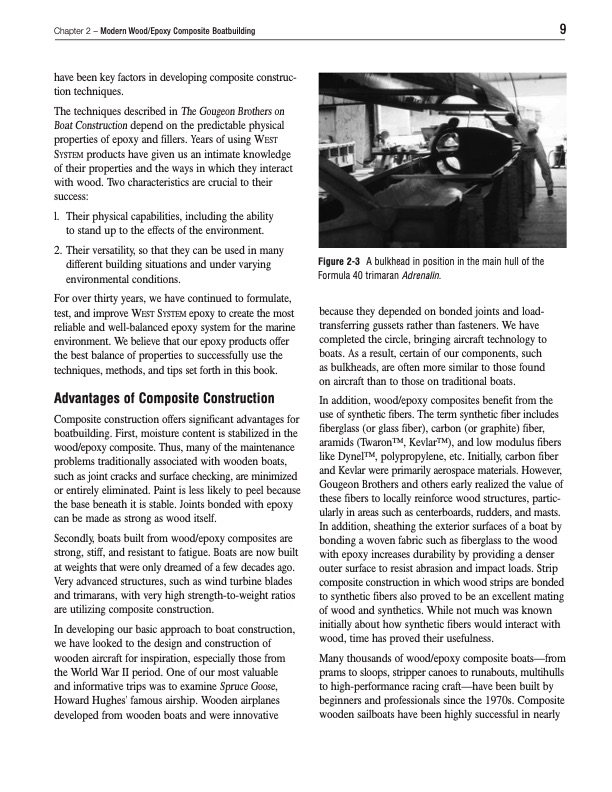
PDF Publication Title:
Text from PDF Page: 023
Chapter 2 – Modern Wood/Epoxy Composite Boatbuilding 9 have been key factors in developing composite construc- tion techniques. The techniques described in The Gougeon Brothers on Boat Construction depend on the predictable physical properties of epoxy and fillers. Years of using WEST SYSTEM products have given us an intimate knowledge of their properties and the ways in which they interact with wood. Two characteristics are crucial to their success: l. Theirphysicalcapabilities,includingtheability to stand up to the effects of the environment. 2. Their versatility, so that they can be used in many different building situations and under varying environmental conditions. For over thirty years, we have continued to formulate, test, and improve WEST SYSTEM epoxy to create the most reliable and well-balanced epoxy system for the marine environment. We believe that our epoxy products offer the best balance of properties to successfully use the techniques, methods, and tips set forth in this book. Advantages of Composite Construction Composite construction offers significant advantages for boatbuilding. First, moisture content is stabilized in the wood/epoxy composite. Thus, many of the maintenance problems traditionally associated with wooden boats, such as joint cracks and surface checking, are minimized or entirely eliminated. Paint is less likely to peel because the base beneath it is stable. Joints bonded with epoxy can be made as strong as wood itself. Secondly, boats built from wood/epoxy composites are strong, stiff, and resistant to fatigue. Boats are now built at weights that were only dreamed of a few decades ago. Very advanced structures, such as wind turbine blades and trimarans, with very high strength-to-weight ratios are utilizing composite construction. In developing our basic approach to boat construction, we have looked to the design and construction of wooden aircraft for inspiration, especially those from the World War II period. One of our most valuable and informative trips was to examine Spruce Goose, Howard Hughes’ famous airship. Wooden airplanes developed from wooden boats and were innovative Figure2-3 Abulkheadinpositioninthemainhullofthe Formula 40 trimaran Adrenalin. because they depended on bonded joints and load- transferring gussets rather than fasteners. We have completed the circle, bringing aircraft technology to boats. As a result, certain of our components, such as bulkheads, are often more similar to those found on aircraft than to those on traditional boats. In addition, wood/epoxy composites benefit from the use of synthetic fibers. The term synthetic fiber includes fiberglass (or glass fiber), carbon (or graphite) fiber, aramids (TwaronTM, KevlarTM), and low modulus fibers like DynelTM, polypropylene, etc. Initially, carbon fiber and Kevlar were primarily aerospace materials. However, Gougeon Brothers and others early realized the value of these fibers to locally reinforce wood structures, partic- ularly in areas such as centerboards, rudders, and masts. In addition, sheathing the exterior surfaces of a boat by bonding a woven fabric such as fiberglass to the wood with epoxy increases durability by providing a denser outer surface to resist abrasion and impact loads. Strip composite construction in which wood strips are bonded to synthetic fibers also proved to be an excellent mating of wood and synthetics. While not much was known initially about how synthetic fibers would interact with wood, time has proved their usefulness. Many thousands of wood/epoxy composite boats—from prams to sloops, stripper canoes to runabouts, multihulls to high-performance racing craft—have been built by beginners and professionals since the 1970s. Composite wooden sailboats have been highly successful in nearlyPDF Image | Gougeon Brothers on Boat Construction

PDF Search Title:
Gougeon Brothers on Boat ConstructionOriginal File Name Searched:
GougeonBook-061205-1.pdfDIY PDF Search: Google It | Yahoo | Bing
Development of a solar powered Electric Ship The Electricship website originally started off as a project to develop a comprehensive renewable, affordable, modular electric ship... More Info
Modular Boat Hull Composite The case for a unsinkable, modular composite hybrid boat hull... More Info
MS Burgenstock Hybrid Electric Catamaran Lake Lucerne Unique shuttle servicing Lucerne to the Burgenstock Resort... More Info
Ground Power Unit GPU Powered by Lithium Ion Batteries The goal of the Ground Power Unit is to provide a readily accessible, modular, ready-to-power solution for remote power... More Info
| CONTACT TEL: 608-238-6001 Email: greg@electricship.com | RSS | AMP |